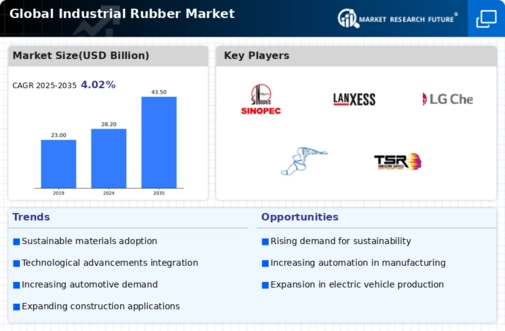Top Industry Leaders in the Industrial Rubber Market

Industrial Rubber Market
The industrial rubber market is a dynamic and ever-evolving space. From conveyor belts powering factories to hoses ensuring safe fluid transport, rubber plays a vital role in diverse industries. Understanding the competitive landscape is crucial for navigating this complex market. Here's an in-depth exploration, including key strategies, market share drivers, industry news, and recent developments:
Strategies for Success:
-
Innovation is Paramount: Leading players are constantly innovating with new rubber compounds, production methods, and sustainable practices. Michelin's self-sealing airless tires and Goodyear's bio-based rubber are prime examples. -
Specialization Pays Off: Focusing on specific niches like high-performance elastomers or custom-engineered solutions can create a competitive edge. Companies like Parker Hannifin and Continental AG excel in this area. -
Geographical Expansion is Key: Emerging markets like China and India offer significant growth potential. Bridgestone's expansion in China and Continental's focus on India are strategic moves in this direction. -
Sustainability Takes Center Stage: Consumers and regulations are increasingly demanding eco-friendly solutions. Companies like Lanxess and Arkema are investing in bio-based rubber and recycled materials. -
Mergers & Acquisitions Drive Growth: Strategic acquisitions can unlock new markets, technologies, and talent. The recent merger of Goodyear and Cooper Tire is a case in point.
Factors Influencing Market Share:
-
Production Capacity and Cost: Efficient production processes and cost-competitive raw materials are crucial for profitability. Major players like The Goodyear Tire & Rubber Company and Sumitomo Chemical Co., Ltd. have a global reach and economies of scale. -
Product Portfolio and Quality: Offering a diverse range of high-quality rubber products caters to diverse customer needs. Companies like Freudenberg and Hutchinson specialize in specific product segments. -
Brand Reputation and Customer Service: Building trust and loyalty through reliable products and exceptional service is essential. Continental AG and Pirelli are known for their strong brand recognition and customer focus. -
Geographical Presence and Distribution Network: A strong presence in key markets and an efficient distribution network ensure market reach. Bridgestone and Michelin have established global networks for optimal reach. -
Technology and Innovation: Continuous investment in R&D and adoption of new technologies like 3D printing can create differentiation. Companies like Evonik and Dow are actively involved in technological advancements.
key Players
- Sinopec (China)
- LANXESS (Germany)
- LG Chem (South Korea)
- Bridgestone Corporation (Japan)
- KUMHO PETROCHEMICAL (South Korea)
- The Goodyear Tire & Rubber Company (U.S.)
- JSR Corporation (Japan)
- ZEON CORPORATION (Japan)
- Versalis S.P.A. (Italy)
- TSRC (Taiwan)
- PJSC "Nizhnekamskneftekhim" (Russia)
Recent Developments :
December 2023: Michelin unveiled its "Vision 2030" strategy, focusing on sustainable materials, circular economy principles, and carbon neutrality in its operations.
November 2023: Goodyear partnered with a startup to develop a self-healing rubber compound for tires, aiming to improve tire lifespan and reduce waste.
October 2023: Bridgestone announced the launch of its "Enliten" technology, which reduces the rolling resistance of tires, leading to improved fuel efficiency in vehicles.
September 2023: The global rubber market witnessed a slight slowdown due to rising raw material prices and economic uncertainties.
In 2023 Cabot Corporation announced that it was launching a new product: Engineered Elastomer Composites (E2C), which aims to meet the needs of industrial rubber products. The new member of the Durability series – E2C DZ8650, intends to decrease field failures and maximize operational uptime. DZ8650 not only provides mechanical strength but also offers breakthrough erosion resistance and wet abrasion resistance properties in slurry pumps, hydro cyclones, and rubber pipes used for mining purposes. Besides, this product can be incorporated into existing production processes by industrial rubber producers without the need for extra capital expenditure. This would help enable manufacturers to transform their business models by enhancing performance, reducing development cycles, and lowering operating barriers to commercializing new products.

